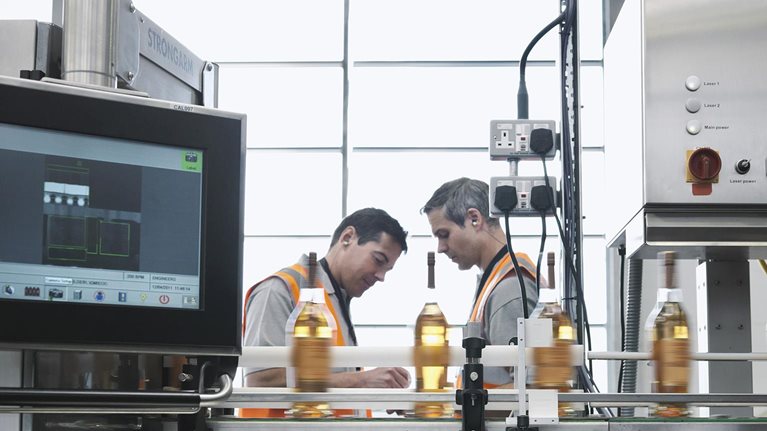In virtually every industry, the Fourth Industrial Revolution (4IR) has spurred a transformative journey that is redefining the very nature of work. While technology has played an essential and often defining role, people have nonetheless remained at the core of these revolutionary transformations.
4IR drives new skills needs
While the type of work varies across different industries and functions, 4IR transformation shifts the workforce away from highly manual tasks to a much more data-driven and automated future. Repetitive, manual factory-floor duties have been replaced with higher-level tasks that involve making data-driven decisions in collaboration with automated technology, including robotics and cobotics (or collaborative robotics).
Building those new skills is the greatest business challenge for 80 percent of CEOs, according to data from the Harvard Business Review.1 Employees are seeing changes in the tools they use, their roles in utilizing them, and what they need to know about how they are functioning. Likewise, new leadership approaches are essential to help individuals and systems achieve maximum impact amid ongoing change, which is no small challenge.
The Fourth Industrial Revolution has ushered in a new world of work, forcing companies to respond with an enthusiastic and strategic approach to workforce capability building. People need knowledge and understanding of new digital tools. And as these revolutionary technologies transform the very nature of the work itself, it’s equally important that everyone from shop-floor workers to senior leaders be willing to redefine what they do—and how they do it—together.
The power of transformative learning
Capability building takes many forms, from hiring new people with new skill sets to outsourcing and entering new partnerships. Here, we are focused principally on upskilling—that is, helping the existing workforce build new capabilities and understand how best to apply them. The experiences of companies that have excelled at capability building point to four compelling reasons for companies to prioritize upskilling when it comes to capability building:
- Hiring or relying on the gig economy usually cannot fill the whole need.
- The business case for reskilling can be roughly one and a half to three times better than for hiring.
- Reskilling enhances company culture and saves time.
- Reskilling is more likely to secure employee buy-in.
This transformative-learning journey involves the entire enterprise at every level. Shop-floor workers master new skills, and senior leaders are called to lead the digital transformation, including the development of new organizational-management approaches that realize people’s full potential. Moreover, leaders model a growth mindset with a visible commitment to their own continual learning.
It is worth reflecting on the nature of teaching and learning. The Latin roots of the English verb “to educate,” ex ducere, mean “to lead out.” Education is predicated on transformative potential. It seeks to lead people out of old ways of thinking, being, and doing and into a new landscape of abundant opportunity. Genuine learning is transformative by nature.
Forging ahead is leading to success
The Global Lighthouse Network, established in 2018 by the World Economic Forum in collaboration with McKinsey, now includes 90 leading sites that have succeeded in 4IR transformation at scale. They have taken the plunge, making bold decisions to engage new technology while keeping their people at the core of change, with many focusing sharply on capability building.
For the four reasons cited earlier, these leading organizations have made it clear that upskilling the current workforce lies at the heart of the most efficient gains. When doing this, the benefits expand across the network, with increasing business impact and ROI. Moreover, this kind of network-wide transformation is not merely a technology upgrade—rather, it’s a transformation of the very nature of work itself.
Compelling questions; innovative answers
How do companies tackle the challenge of capability building across their enterprise? How are leading organizations maximizing the potential of their people and keeping the 4IR transformation journey inclusive of each worker? And how are they doing so across the broad range of roles, responsibilities, skill sets, and experience levels that comprise a 21st-century company? Read on to explore these compelling questions—and discover an innovative, four-tiered approach to achieve lasting impact.
A capability-building case study
First, let’s take a look at a real case study that illustrates capability building at the core of transformative change. A large transmission system operator (TSO) in Europe faced the challenge of doubling its annual fieldwork output to meet rising demand from new infrastructure associated with the green-energy transition, as well as increased maintenance and equipment-replacement needs. The bottleneck lay with the technical workforce, whose capability deficits were leading to delays in the capacity-building plan and an increasing work backlog.
The company needed to begin with a clear willingness to transform and couple that with a commitment to capability building. That required recognizing that transforming an enterprise involves both people and technology. Moreover, part of this commitment included sustainment. Once the capability-building mechanisms were implemented, the company needed rigorous governance and clear KPIs that could work together to ensure ongoing training quality, adherence to what had been learned, and continued assessment to measure the maturity of learning and transformation.
Assessment is at the core of an effective capability-building program. A company must identify business needs, assess skills among its people, identify gaps in those skills, and then strategically link the gaps to the relevant business needs (Exhibit 1). This process ensures that the academy is fact based and directly linked to business-improvement goals.

The large TSO developed an effective learning journey for both existing and new fit-for-purpose roles across all geographical areas. This journey began with a clear understanding of business goals that would support the target capacity increase—reducing unnecessary workloads, improving training speed, changing mindsets and behaviors, boosting delivery workflow efficiency for maintenance and projects, and introducing field performance management. Key to this strategic approach was the use of an organizational skills index (OSI), which enabled meaningful assessment of employees’ current skill levels across functional, leadership, and transformation skills.
The TSO was able to boost its capacity within a year by 35 percent through two key changes. First, it directly increased the effectiveness of its people; second, it was able to accelerate the onboarding of new employees from three years to one and a half years. By utilizing the OSI results to inform the approach, the company was able to tailor each team’s learning journey for maximum effectiveness.
Challenges of workforce transformation
As companies seek to undergo the digital shift at the core of 4IR transformation, they face challenges. Transformational change is inherently difficult—it asks people to upend traditional, often “proven” ways of doing things and to step outside of comfortable, familiar routines. Let’s look at four central challenges.
Boosting technical and leadership capability
For manufacturing companies, transformation across the board is a complex task because it requires change on two broad levels that, while related, are quite distinct. First, there are hands-on technical skills. Everyone from shop-floor operators and technicians to middle managers to senior leaders is confronted with compelling new digital tools ranging from new apps and software to IoT devices. Mastering them requires new content knowledge (knowing what to do and how to do it) and developing understanding (when to do it and why).
But beyond boosting technical capability lies another category of essential learning: new leadership skills. Leaders at every level, from the shop floor to the C-suite, face the challenge of learning how to organize, communicate, delegate, facilitate, and manage a workplace and a workforce undergoing technical transformation. Amid any substantial change come the human elements of stress, uncertainty, and, often, even fear. Leaders are tasked with stewarding their people through what can be demanding and disruptive adaptations.
Different cohorts have different needs
Even within a single company, there exists a broad range of diverse roles. While some areas of the organization may require considerable focus on practical, hands-on skills, others will need more emphasis on leadership and management techniques. Moreover, even within these broader categories lie multiple cohorts whose jobs look quite different.
The range and diversity of roles present a challenge in understanding skills gaps and where best to focus capability-building efforts. This underscores the need for smart, dynamic diagnostic tools that can provide meaningful insights throughout the organization, applicable and equally effective across distinct categories, systems, and functions.
Sizing the capability-building program
While tailored learning is important, a piecemeal approach is insufficient. Typically, the more effective solution involves every level of the organization, from associates to senior global leaders. So how can leaders rightsize the program without overwhelming the company? How can leaders make sure that the right people receive the right training without extraneous or excessive content that will detract from what matters most for their jobs?
If the approach is too small, the capability building could fall short. Pockets of the company—those with the most obvious skills gaps—might receive sufficient attention and resources. But what about other areas where the relevant upskilling needs are less apparent? Rightsizing the program is essential. It must be comprehensive enough to involve all levels of the enterprise, but the approach must be strategic so that resources can be allocated intelligently for lasting impact.
Reconciling cost with ROI
Speaking of allocation, companies must consider the resources available to invest in capability building. These will likely be lower in typically small or midsize sites across an extensive network. Leaders face the challenge of ascertaining the right investment in capability building weighed against anticipated ROI.
Additionally, the broader the network, the more likely it is that culture and language differences will factor into the complexity and cost of capability-building efforts. Workers in one part of the world may approach learning in very different ways from workers in another. Across an extensive network, training efforts require broader deployment in more varied forms.
Capability-building solutions
We’ve explored some of the challenges that companies face as they undertake capability building, especially across extensive networks. So, what works? How can companies approach this essential part of their 4IR transformation, keeping people at the core? Here we present an effective four-tiered process.
1. Put an ROI on capability building
It’s vital to articulate a direct rationale for capability building. If people don’t clearly understand why they need to master new skills, the challenge is compounded. To build quick momentum that drives capability-building efforts, leaders begin by sharing an unambiguous value proposition. If people know what they’re building toward, the process has momentum from the start.
Of course, to do this smartly, it is essential to assess where to direct capability-building efforts to most effectively yield ROI for the company. Leaders employ a strategic approach that inventories current skills and effectively identifies gaps linked to impact. This involves quantifying aspects of a company’s capability and maturity and identifying specific gaps that can be linked to business objectives. In the case-study reference, the company leveraged an in-depth diagnostic to achieve this kind of detailed view. The resulting insights supported tailored learning journeys with a clear link to value creation.
2. Map out tailored learning journeys
The learning journey won’t be the same across the board. Because of the diversity of roles and responsibilities within an organization, the road map will look different for different functions. Accordingly, a challenge for senior leadership is to develop the mindset needed to lead during the digital transformation. Midlevel leaders are tasked with understanding new processes and ways of working, and task-specific experts need to hone new digital skills such as analytics.
Leaders then consider various business objectives and KPIs, then make informed decisions using data from their skills-gap diagnostic to plot effective paths forward for different parts of the organization. This can include smart sequencing of content directly tied to specific business objectives, which ensure not only skill building but also the types of behavior change essential to utilize and sustain those skills.
3. Engage innovative adult-learning methods
Organizations need proven learning methods that engage adult-learning principles and emphasize practicality—leaving workers no questions about the relevance of what they’re learning. Likewise, successful learning approaches incorporate an experiential focus, with hands-on methods that directly utilize the associated skills and knowledge. Gamification can be valuable, as it can combine effective mechanisms with an enticing, fun approach that builds camaraderie.
A variety of techniques can enhance the experience, ranging from e-learning to in-person and virtual workshops, experiential learning, and fieldwork (Exhibit 2). Moreover, ongoing coaching can help refine, sustain, and deepen the process while building rapport among workers.

4. Apply rigorous governance
To truly be transformative, change must be sustained through rigorous governance. Leaders who wish for their organizations to avoid slipping back to the status quo must be sure to set standards and benchmarks and be sure they are articulated clearly and tied to measurables. Moreover, leaders need to be attentive to the progress of the learning journey past the initial phase. This should include some degree of “homework” that can be monitored to measure adherence to the training against specific criteria.
Indeed, one of the challenges of sustaining a major organizational change lies within the fact that over time, enthusiasm can wane as novelty fades. This can be mitigated, of course, by having done the essential work up front to make the ROI case clear—but even if the value proposition is well understood, sustaining transformative change remains challenging. Rigorous governance helps leaders keep a finger on the pulse to ensure that people remain energized about that value proposition.
Lead forth
The shifts occurring amid the 4IR across sectors and industries are not slowing down—rather, they are accelerating. Just as people are at the core of these shifts, they are likewise at the core of responding to them. Many of the leading companies among the Global Lighthouse Network have prioritized people, putting a premium on capability building.
By taking the time to assess strengths and areas for growth, identify specific skill gaps connected to business goals, and then courageously invest in effective learning methods tailored to their people, leaders can empower their companies by empowering their workers with the 4IR skills at the heart of 21st-century capability. Building the workforce of the future means embarking on a transformative-learning journey out of the old ways of thinking and doing and into the landscape of the future.
After all, to educate is to lead out—and lead forth.


